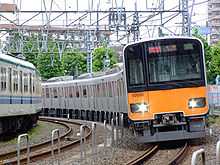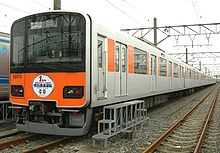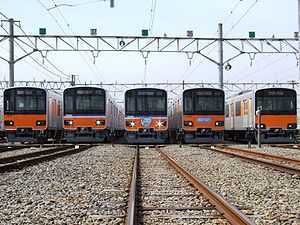Tobu 50000 series
| Tobu 50000 series | |
|---|---|
|
Lineup of Tojo Line 50070/50090/50000 series trains, March 2008 | |
| In service | 2005–Present |
| Manufacturer | Hitachi |
| Family name | Hitachi A-train |
| Constructed | 2004–2011 |
| Number built | 390 vehicles (39 sets) (as of April 2012) |
| Formation | 10 cars per trainset |
| Operator | Tobu Railway |
| Depot(s) |
Shinrinkōen (50000, 50070, 50090 series) Minami-Kurihashi (50050 series) |
| Line(s) served | Tobu Tojo Line, Tobu Skytree Line, Tobu Isesaki Line, Tokyo Metro Hanzomon Line, Tokyo Metro Yurakucho Line, Tokyo Metro Fukutoshin Line, Tokyu Den-en-toshi Line |
| Specifications | |
| Car body construction | Aluminium |
| Car length | 20,000 mm (65 ft 7 in) |
| Width | 2,800 mm (9 ft 2 in) (2,770 mm (9 ft 1 in) for 50050 series) |
| Doors | 4 pairs per side |
| Maximum speed |
100 km/h (Tobu tracks) 80 km/h (Tokyo Metro lines) 110 km/h (Tokyu Denentoshi Line) |
| Traction system | VVVF |
| Acceleration | 3.3 km/h/s |
| Deceleration |
3.5 km/h/s (service) 4.5 km/h/s (emergency) |
| Electric system(s) | 1,500 V DC |
| Current collection method | Overhead lines |
| Safety system(s) | Tobu ATS, Tokyo Metro CS-ATC (50050 series and 50070 series), Tokyu CS-ATC (50050 series only), Tokyo Metro ATO (50070 series only) |
| Track gauge | 1,067 mm (3 ft 6 in) |
The Tobu 50000 series (東武50000系 Tōbu 50000-kei) is a commuter electric multiple unit (EMU) train type operated by the private railway operator Tobu Railway in Japan, manufactured by Hitachi to its "A-train" concept. The trains represent the first use of aluminium body cars on Tobu commuter trains. They are also the first Tobu trains to feature bilingual (Japanese and English) automated passenger announcements.
Variants
- 50000 series: 9 x 10-car sets introduced from March 2005 on the Tobu Tojo Line
- 50050 series: 17 x 10-car sets introduced from March 2006 on Tobu Skytree Line inter-running services
- 50070 series: 7 x 10-car sets introduced from July 2007 on Tobu Tojo Line inter-running services
- 50090 series: 6 x 10-car sets with variable seat configurations introduced from June 2008 on Tobu Tojo Line TJ Liner services
50000 series
The first 50000 series set, 51001, was delivered in November 2004 and entered service on the Tobu Tojo Line on 16 March 2005, followed by second-batch set 51002 in October 2005. The second set differs in having an emergency door in the front ends, and externally resembles the 50050 series used on the Tobu Skytree Line (see below).[1]
Two more sets, 51003 and 51004, were delivered during fiscal 2009.[2] 50003 was delivered to Shinrinkōen Depot in January 2010,[3] followed by 50004 in February 2010.[4] These two sets have pairs of opening windows and interiors based on sets 51061 onward.
-

Set 51001 with no front-end doors, July 2008
-
Set 51002 with front-end doors, May 2006
-
Set 51002 with modified side windows including opening sections, October 2014
| Year built | Set numbers | External features | Internal features |
|---|---|---|---|
| 2004 | 51001 | ||
| 2005 | 51002 | Emergency front end doors | |
| 2009–2010 | 51003–51009 | Pairs of windows instead of large single pane. | Redesigned seats with darker blue moquette. Conventional handrails next to doors. |
Total number of vehicles built: 90 (as of October 2010)
Formation
| Car No. | 10 | 9 | 8 | 7 | 6 | 5 | 4 | 3 | 2 | 1 |
|---|---|---|---|---|---|---|---|---|---|---|
| Designation | Tc1 | M1 | M2 | T1 | M3 | T2 | T3 | M1' | M2' | Tc2 |
| Numbering | 51000 | 52000 | 53000 | 54000 | 55000 | 56000 | 57000 | 58000 | 59000 | 50000 |
The 52000, 55000, and 58000 cars each have one single-arm pantograph.[1]
Interior
-

Interior view of set 51001 showing original seat style, August 2011
-
Interior view of set 51004 showing newer seat style and conventional handrails at the doorways, March 2010
50050 series

The 10-car 50050 series sets were built for use on the Tobu Isesaki, Skytree and Nikko lines, and inter-running services through the Tokyo Metro Hanzomon Line to the Tokyu Den-en-toshi Line displacing the earlier 30000 series sets.[5]
The first set (51051) entered service on 18 March 2006, and as of January 2007, 10 sets were in service. While broadly based on the Tojo Line 50000 series design with emergency end doors, cars are 30 mm narrower (2,770 mm compared with 2,800 mm) to cope with reduced clearances on the subway lines.
Sets 51061 onward have different seat covers and pairs of opening windows (like the 50090 series) instead of the large single-pane sealed windows on earlier units.
Two more sets (51066 to 51067) were delivered during fiscal 2009.[2]
From October 2012, set 51052 was modified with opening panes in four side windows per car, in the same style as Tojo Line set 51075 and JR East 209 series sets.[6]
| Year built | Set numbers | External features | Internal features |
|---|---|---|---|
| 2006 | 51051–51060 | Emergency end doors | |
| 2007–2009 | 51061–51067 | Pairs of windows instead of large single pane. | Redesigned seats with darker blue moquette. Conventional handrails next to doors. |
Total number of vehicles built: 170 (as of October 2010)
Formation
| Designation | Tc1 | M1 | M2 | T1 | M3 | T2 | T3 | M1' | M2' | Tc2 |
|---|---|---|---|---|---|---|---|---|---|---|
| Numbering | 51050 | 52050 | 53050 | 54050 | 55050 | 56050 | 57050 | 58050 | 59050 | 50050 |
| Weight (t) | 27.5 | 33.0 | 32.5 | 23.0 | 31.5 | 23.0 | 23.0 | 33.0 | 32.5 | 27.5 |
| Capacity (total/seated) |
137/48 | 152/51 | 151/54 | 151/54 | 151/54 | 151/54 | 151/54 | 151/54 | 152/51 | 137/48 |
The 52050, 55050, and 58050 cars each have one single-arm pantograph.[5]
Interior
-

Early batch type interior
-

Interior of set 51061
50070 series

The 10-car 50070 series sets were built for use on Tobu Tojo Line and Tokyo Metro Yūrakuchō Line inter-running services, and also on Tokyo Metro Fukutoshin Line inter-running services from June 2008.[7]
The first set (51071) was delivered in early March 2007, entering revenue-earning service in July. It differs from earlier variants in having full-colour LED destination indicators, and is also equipped with ATO for subway operation.
A total of four sets were delivered by March 2008.[8]
A fifth set, 51075, was delivered in August 2008.[9] This set differs in having opening windows similar in design to those added to JR East 209 series EMUs.[6]
A further two sets, 51076 and 51077, were delivered during fiscal 2011, with 51076 delivered in November 2011,[10] and 51077 in January 2012.[11] These sets differ in having 17" LCD displays above every door, instead of the LED dot-matrix displays used on earlier sets, and also have pairs of opening side windows instead of the large single panes.
| Year built | Set numbers | External features | Internal features |
|---|---|---|---|
| 2008 | 51071–51074 | Full-colour LED destination indicators | |
| 2008 | 51075 | Opening sections included in windows. | |
| 2011 | 51076–51077 | Pairs of windows instead of large single pane. | 17" LCD displays above doors. |
Total number of vehicles built: 70 (as of April 2012)
Formation
| Car No. | 10 | 9 | 8 | 7 | 6 | 5 | 4 | 3 | 2 | 1 |
|---|---|---|---|---|---|---|---|---|---|---|
| Designation | Tc1 | M1 | M2 | T1 | M3 | T2 | T3 | M1' | M2' | Tc2 |
| Numbering | 51070 | 52070 | 53070 | 54070 | 55070 | 56070 | 57070 | 58070 | 59070 | 50070 |
| Capacity (total/seated) |
140/48 | 154/51 | 153/54 | 153/54 | 153/54 | 153/54 | 153/54 | 153/54 | 154/51 | 140/48 |
The 52070, 55070, and 58070 cars each have one single-arm pantograph.[7]
Interior
-

Interior of 50070 series set
-
LCD passenger display screen inside set 51076
50090 series
Four 10-car 50090 sets were delivered in February and March 2008 for use on new Tobu Tojo Line limited-stop evening TJ Liner services starting from the start of the new timetable on 14 June 2008.[12] Internally, these trains feature rotating seats that can be arranged longitudinally for daytime services and in forward-facing transverse pairs for "Liner" services. These trains are also used on up "Rapid Express" services. Externally, the sets feature a blue waistline stripe running the length of each car, with a "TOJO LINE" logo.[13]
A public preview run of the 50090 series took place on 23 March 2008 from Ikebukuro to Shinrinkōen station, followed by a photographic event at Shinrinkōen depot.[14]
A fifth set, 51095, was delivered from Hitachi in September 2010,[15] followed by 51096 in November 2010, in preparation for an increase in the number of TJ Liner services from the start of the revised timetable on 5 March 2011.[16]
| Year built | Set numbers | External features | Internal features |
|---|---|---|---|
| 2008 | 51091–51094 | Pairs of windows. Full-colour LED destination indicators. | Rotating seat pairs |
| 2010 | 51095–51096 | Conventional handrails next to doors. |
Total number of vehicles built: 60 (as of November 2010)
Formation
| Car No. | 10 | 9 | 8 | 7 | 6 | 5 | 4 | 3 | 2 | 1 |
|---|---|---|---|---|---|---|---|---|---|---|
| Designation | Tc1 | M1 | M2 | T1 | M3 | T2 | T3 | M1' | M2' | Tc2 |
| Numbering | 51090 | 52090 | 53090 | 54090 | 55090 | 56090 | 57090 | 58090 | 59090 | 50090 |
| Weight (t) | 28.2 | 33.9 | 33.4 | 25.5 | 32.3 | 25.5 | 25.5 | 33.9 | 33.4 | 28.2 |
| Capacity (total/seated) longitudinal config. |
124/42 | 136/45 | 135/48 | 135/48 | 135/48 | 135/48 | 135/48 | 135/48 | 136/45 | 124/42 |
| Capacity (total/seated) transverse config. |
118/42 | 131/45 | 129/48 | 129/48 | 129/48 | 129/48 | 129/48 | 129/48 | 131/45 | 118/42 |
The 52090, 55090, and 58090 cars each have one single-arm pantograph.[17]
Interior
The 50090 series sets have seats that can be rotated and configured in longitudinal style for regular daytime services or in forward-facing transverse style for TJ Liner services and Ikebukuro-bound Rapid Express services.[18] When configured in transverse mode, the rows have a seat pitch of 1,000 mm (39 in).[18]
-
Interior view of a 50090 series in forward-facing transverse configuration
-
Seats of 50090 series in transverse configuration
-

Seats of 50090 series in longitudinal configuration
-

Priority seats with armrests
References
- ↑ 1.0 1.1 "東武鉄道50000系2次車" [Tobu 50000 series 2nd-batch set]. Japan Railfan Magazine (Japan: Koyusha Co., Ltd.) 46 (537): p.87. January 2006.
- ↑ 2.0 2.1 "その後の東京メトロ・東武・西部の話題" [Subsequent Tokyo Metro, Tobu, and Seibu topics]. Japan Railfan Magazine (Japan: Koyusha Co., Ltd.) 49 (578): p.64–69. June 2009.
- ↑ 東武鉄道50000系50003編成が甲種輸送される [Tobu 50000 series set 50003 delivered]. Japan Railfan Magazine Online (in Japanese). Koyusha Co., Ltd. 25 January 2010. Retrieved 8 February 2010.
- ↑ "EF210-160が東武鉄道50000系の甲種輸送をけん引" [EF210-160 delivers Tobu 50000 series]. Japan Railfan Magazine Online (in Japanese). Koyusha Co., Ltd. 8 February 2010. Retrieved 8 February 2010.
- ↑ 5.0 5.1 "東武鉄道50050系" [Tobu 50050 series]. Japan Railfan Magazine (Japan: Koyusha Co., Ltd.) 46 (538): p.104–108. February 2006.
- ↑ 6.0 6.1 東武50050系に側窓開閉化改造施行車 [Tobu 50050 series modified with opening side windows]. Japan Railfan Magazine Online (in Japanese). Japan: Koyusha Co., Ltd. 17 October 2012. Retrieved 17 October 2012.
- ↑ 7.0 7.1 "東武鉄道50070系" [Tobu 50070 series]. Japan Railfan Magazine (Japan: Koyusha Co., Ltd.) 47 (555): p.84–87. July 2007.
- ↑ "東武鉄道 50070系/9000系(地下鉄副都心線乗入れ対応車)" [Tobu Railway 50070 and 9000 series sets for Fukutoshin Line subway inter-running]. Tetsudō Daiya Jōhō Magazine (Japan: Kotsu Shimbun) 36 (278): p.75. June 2007.
- ↑ "甲種鉄道車両輸送計画表)" [Rolling stock delivery schedule]. Tetsudō Daiya Jōhō Magazine (Japan: Kotsu Shimbun) 37 (293): p.127. September 2008.
- ↑ "東武鉄道50070型51076編成の甲種輸送をEF66 33が牽引" [Tobu 50070 series set 51076 hauled by EF66 33]. RM News (in Japanese). Japan: Neko Publishing. 28 November 2011. Retrieved 5 December 2011.
- ↑ "50070型51077Fが甲種輸送される" [Tobu 50070 series set 51077 delivered]. RM News (in Japanese). Japan: Neko Publishing. 18 January 2012. Retrieved 14 April 2012.
- ↑ Tetsudō Daiya Jōhō Magazine, February 2008 issue, p126
- ↑ 2008年6月 東武東上線に新ライナー登場 [New Tojo Line Liner trains starting in June 2008] (PDF). Tobu News (in Japanese). Tobu Railway. 21 November 2007.
- ↑ "Your Tōjō" February 2008 issue
- ↑ 東武50090系が甲種輸送される [Tobu 50090 series delivered]. Japan Railfan Magazine Online (in Japanese). Koyusha Co., Ltd. 5 September 2010. Retrieved 6 September 2010.
- ↑ "東武鉄道50090系甲種輸送をEF65 1127がけん引る" [Tobu 50090 series delivered by EF65 1127]. Japan Railfan Magazine Online (in Japanese). Koyusha Co., Ltd. 15 November 2010. Retrieved 15 November 2010.
- ↑ "東武鉄道50090系" [Tobu 50090 series]. Japan Railfan Magazine (Japan: Koyusha Co., Ltd.) 48 (566): p.66–69. June 2008.
- ↑ 18.0 18.1 Kusui, Toshihiko (June 2014). 特別料金不要のクロスシート車総覧 [An overview of transverse-seating trains not requiring supplementary fares]. Tetsudō Daiya Jōhō Magazine (in Japanese) (Japan: Kōtsū Shimbun) 43 (362): p.7.
External links
| Wikimedia Commons has media related to Tobu 50000 series. |
- Tobu 50000 series (Japanese)
| ||||||||||||||||







